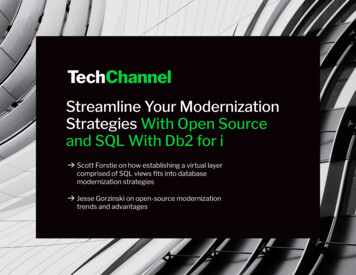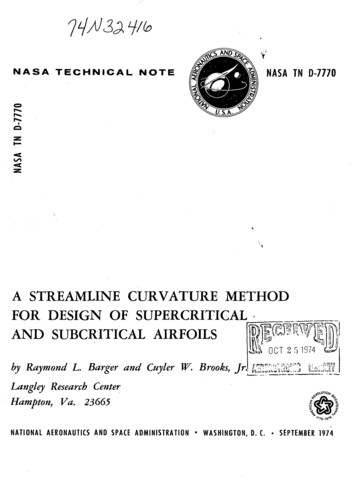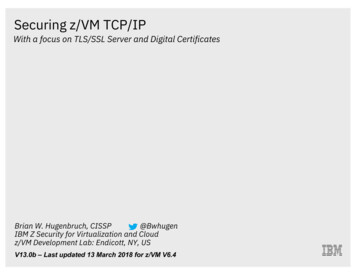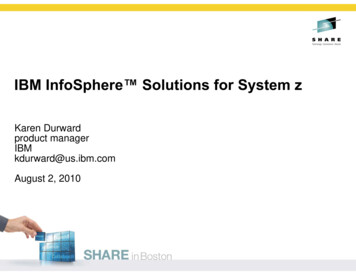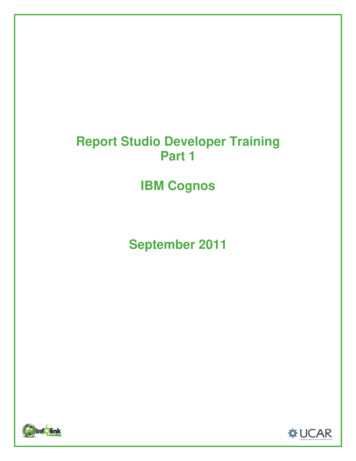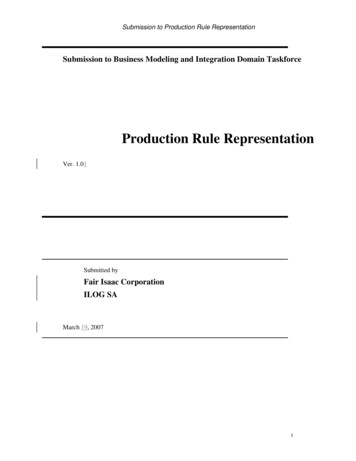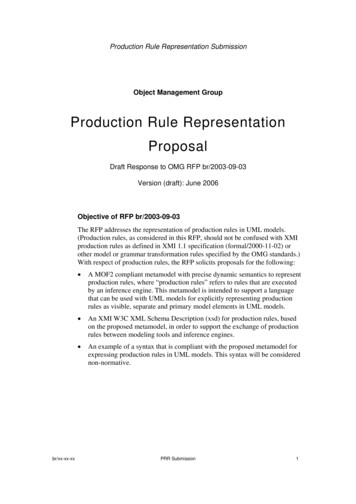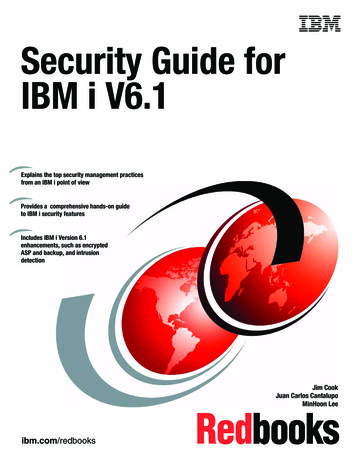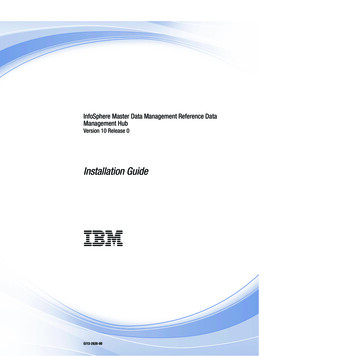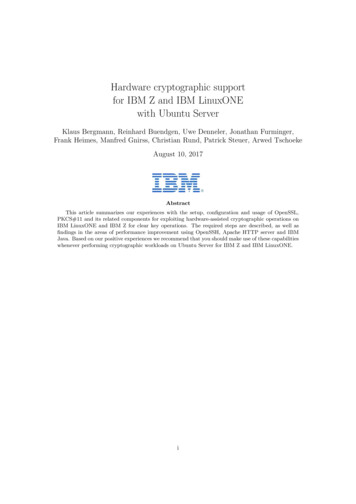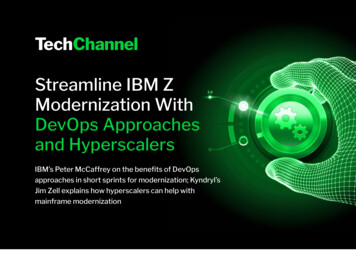
Transcription
TechChannelStreamline IBM ZModernization WithDevOps Approachesand HyperscalersIBM’s Peter McCaffrey on the benefits of DevOpsapproaches in short sprints for modernization; Kyndryl’sJim Zell explains how hyperscalers can help withmainframe modernization
FROM THE EDITORcontentsRethinking MainframeModernization3 A Series of Sprints toModernize Applications7 The Pandemic andModernizing YourMainframe9 An Introduction toHyperscalers andMainframes14 When MainframeModernizationIs Actually anImprovement:Building on SuccessAs technology and business constantly evolve, so dorequirements for change—making modernization topof mind for organizations hoping to keep up with keybusiness objectives and needs.With this in mind, it’s more important than everto develop an effective modernization strategythat specifically fits these needs. We’re beyond “one-size-fits all”approaches—instead, enterprises should move toward targetedapproaches that take advantage of tools and options tailored to theirbusiness objectives. Mainframe-based businesses also need to transitionto a DevOps approach, which means teams can fail fast and recoverimmediately throughout application modernization efforts.Partnering with hyperscalers like Microsoft, Amazon and Google andoffloading physical management of infrastructure can also help duringthe mainframe modernization process. However, taking advantage ofwhat hyperscalers offer depends on what problem you are solving.In this e-book, IBM’s Peter McCaffrey explores the benefits of DevOpsapproaches in short sprints for modernization, and Kyndryl’s Jim Zellexplains how hyperscalers can help with mainframe modernization.Keelia Estrada Moeller, Senior Editor2Streamline IBM Z Modernization With DevOps Approaches and Hyperscalers
SPONSORED BYA Series of Sprints toModernize ApplicationsLOGOIBM’s Peter McCaffrey on why you should transitionfrom waterfall application modernization approaches,to DevOps approaches in short sprintsBY DAVA STE WAR T“You’re probably familiar with the saying thatthere are two certainties in life: death andtaxes. Well, for large enterprises, thereare also two certainties: digital transformation andapplication modernization,” says Peter McCaffrey, IBM Zsoftware product management GTM, IBM.Both technology and business are ever-evolving andthat produces a constant requirement for change.However, modernization just for the sake of it, withouta clear business objective, is pointless. The first step in3Streamline IBM Z Modernization With DevOps Approaches and Hyperscalersimplementing efforts to modernize applications is defininga clear business purpose. “Often, it’s an effort to enhancethe customer experience. It’s trying to enrich the customerexperience and compel them to do business with themversus the other guy,” says McCaffrey.Enriching the customer experience frequently involveshaving access to real-time information. When a companyhas information about a customer, they can offer productsand services suited to the customer’s situation. “Thatoften requires reaching back to existing applications and
business workflows to get data that can deliver insight atthe moment of impact,” says McCaffrey.Most people have had the experience of shopping for alower price on auto or homeowners insurance, and thatillustrates the kind of situation McCaffrey is describing.A person who has separate policies with two differentcompanies might want to find out if they could get a lowerprice by bundling their policies with one company.The customer might sign into a mobile application andmake the inquiry. The application needs to know howmany automobiles the person has and their customerhistory. That information likely resides on the corebusiness application, which is probably running on themainframe. Marrying pricing algorithms with the customerhistory means the company can offer some dynamicpricing options, so if the customer adds a homeownerspolicy they might get a particular discount, or if they adda vehicle they get a different one. Some such algorithmsare very sophisticated and base the results on numerousfactors such as zip code, car model and so on.In order to provide that rich, personalized experience, thecompany needs to use modernized applications that havethe capability of accessing information in a timely manner.The customer wants to know how much they can savewhile they are looking, not next week when an agent hastime to call them.4Streamline IBM Z Modernization With DevOps Approaches and Hyperscalers
Customized IsBetter Than OneSize Fits AllOnce an enterprise has identified aclear business need that applicationmodernization can meet, thequestion of how to go about itbecomes paramount. There areoptions—and navigating them canbe confusing. Simply migratingeverything may appear to be thesimplest, most comprehensivesolution, but McCaffrey says hehas seen the “one-size-fits-allapproach” become a nonstartermany times. Businesses find thatmoving everything to the publiccloud is costly and complex. Eachapplication can contain millions oflines of code.A more targeted approach thattakes advantage of tools andoptions and is tailored to thebusiness objective makes muchmore sense in most cases. “Youhave to consider the data,” says5Streamline IBM Z Modernization With DevOps Approaches and HyperscalersFree, Expert-Led Education;Live or On-DemandWant to keep up on the latest IT trends? Wondering what yourpeers are doing? Need a solution for a business challenge?With many in-person conferences and expos on hold, there’s nobetter way than complimentary, expert-led TechChannel Webinarsto get the latest on all things tech. Attend now and interact with thetechnologists; ask the questions that matter most to you.View all live andon-demand webinars
McCaffrey. “There’s very much an 80/20 rule that saysbasically 80% of the app is probably fine, and 20%probably needs to be modernized and enhanced. Why notjust address the 20%, versus a migration approach whichinvolves touching all 100%?”“Business leaders want to achieve their businessobjectives at the lowest cost, with the least risk, andwithout compromising their compliance posture,” notesMcCaffrey. By identifying a clear business objective,targeting modernization efforts toward meeting thatobjective, and using the tools and processes available withprecision, enterprises can achieve digital transformationthrough application modernization successfully.In the past, application development efforts were oftendone according to the waterfall method, which involvesgathering and analyzing data, designing, developing, thentesting and deploying. Each step is dependent on the onebefore, and the process can be time consuming. Failuresrepresent the loss of a hefty investment of time.From a Waterfall to a SprintToday, mainframe-based businesses need to transition fromthat waterfall process to a DevOps approach that meansteams can fail fast and recover immediately. “DevOps allowsfor smaller sprints where you add feature and function6Streamline IBM Z Modernization With DevOps Approaches and Hyperscalerscontinuously over a period of time, in maybe two-weeksprints,” says McCaffrey. The team defines a piece of workthat can be accomplished in two weeks, they release it, getfeedback, and move on to the next piece of work. It’s a muchmore agile method of modernizing and makes better use ofresources and time.“We work with a number of mainframe accounts today thatare transitioning from that waterfall approach to DevOps,”says McCaffrey, noting that the approach also meansdevelopers can work in modern programming languages.Many mainframe applications were developed using COBOL,for example, and developers with COBOL skills are becomingscarcer. By taking an approach that simply seeks to enhanceand extend an application, rather than migrate it entirely,developers can use a more modern programming language.The process minimizes the amount of change that needs tohappen and at the same time leverages existing resources.“Businesses adapt to a cloud-native or microservices-basedmodel using smaller programming units that integrate andwork with one another,” says McCaffrey.As an example of how an enterprise can use informationstored on the mainframe in concert with modernized,enhanced and extended applications, McCaffrey describesa pattern he sees developing around event-drivenapplications. In the banking industry, it’s common for theenterprise to notify a customer if a transaction of more thansome defined amount takes place.
The Pandemic andModernizing YourMainframe“The transfer is the event, and it likely takes place on themainframe,” McCaffrey notes. “It gets put in a queue thatnotifies an app, and some logic is triggered. It could bea push notification, like an email or a text. The customerreceives a notification that basically asks, ‘Did you makethis transaction?’”“The original applications don’t need to change much insituations like that,” says McCaffrey. “They just need toidentify that the event happened. All the rest comes fromnew applications and services that work together, andthat may be in different programming languages or run indifferent environments.” This method offers an efficientway to modernize existing applications, and can beimplemented using a DevOps approach in short sprints.There’s Always a New Modelof ComputingMcCaffrey advises enterprises undertaking amodernization effort to keep in mind that things arealways changing. “I’ve been in the industry for a long time,and I’ve seen us transition through different models ofcomputing,” he says. Each time, there are people whothink they need to transition everything to the new model.“But what they undoubtedly find is that it’s extremely hardto do.”7Streamline IBM Z Modernization With DevOps Approaches and HyperscalersBY TR E VO R EDDO LL SThe 2021 Mainframe Modernization BusinessBarometer Report from Advanced examines thecurrent mainframe market and the challenges facingenterprises worldwide with annual revenues of more than 1 billion. It also explores the impact COVID-19 is having,and will continue to have, on modernization plans.To give a baseline, the report found that the averageenterprise consumes 33,286 MIPS every month. Andorganizations are spending an average of 4,266 perMIPS annually, factoring in the cost of maintenance,software licensing, hardware, operational andmodernization costs. This, the report suggests,equates to an average of 142 million a year.The Advanced 2021 survey also found that 64% oforganizations use mainframe-based applicationsthat are between 10 and 20 years old. And 28%are between 20 and 30 years old. This, you mightconclude, just shows the longevity of mainframeapplications—although that wasn’t the survey’s conclusion. The 2021 report found that mainframe-based
applications comprised an average of 8.86 million linesof code—written in multiple languages—across a al40%ADS/OnlineThe most prominent languagesin mainframe b258%IDMS28%IMSWhen it comes to the programming language in use,perhaps not surprisingly, 75% of the enterprises surveyedsaid COBOL remains the most prominent language intheir mainframe estate. Assembler was found at 66%.Natural was at 41% and ADS/Onlineat 40%. The survey100also asked what data/database structures mainframesuse. They found that 76% use Adabas, 65% use Db2,58% use IDMS, 28% use IMS and 23% use VSAM.A total of 89% of respondents said that they are0concerned about having accessto the right IT talent rlyandextend their legacy systems. Bycontrast,36% areconcerned that people entering e only have “modern” skills (i.e., Java, Python,C#, and cloud-native deployment and orchestration toolssuch as Docker and Kubernetes), while 33% are worriedstaff are retiring and taking their legacy skills with them.The survey also found that 29% of respondents say theirstaff don’t want to learn legacy skills, while 28% fearthey may lose talent to competitors using more “modern”technologies (i.e., DevOps and cloud ecosystems).23%VSAMData/database structures usedby mainframesStreamline IBM Z Modernization With DevOps Approaches and HyperscalersRead more
SPONSORED BYLOGOAn Introduction to Hyperscalersand MainframesHow popular hyperscalers—including Microsoft, Google and Amazon—relate to IBM Z technology and modernizationBY J I M ZELLAclose friend recently asked me what a hyperscaleris. I explained that at a high level, hyperscalersare technology companies that make hugeinvestments in infrastructure and services to dominatethe cloud industry and to have the capability to expandinto any market. They can handle truckloads of traffic,have capability to scale up or down quickly, offerinfrastructure as a service (Iaas), software as a service(SaaS) and are constantly innovating. They do this for hugecorporations, small businesses and individuals.Organizations can benefit greatly by partnering withhyperscalers and offloading the physical managementof infrastructure to them. There are many otheradvantages but the focus of this article is to explain what9Streamline IBM Z Modernization With DevOps Approaches and Hyperscalersthe hyperscalers are doing that relates to mainframetechnology. There are also dozens of companies inthe hyperscaler category but these three have made aparticularly significant impact in the world of mainframetransformative technology: Microsoft, Amazonand Google.These companies advertise their services as mainframemodernization, but they’re not in the business of modernizing the mainframe platform in any way. Instead, theyhave established use cases for migrating workloads awayfrom the mainframe and in some instances have createdbusiness intelligence and analytics tools that use mainframe data. Here’s how Microsoft, Amazon and Googlepertain to the mainframe:
MicrosoftMicrosoft’s focus is mainframe workload migration to their cloud platform, Azure. “The MainframeTransformation program” is Microsoft’s new mainframemodernization initiative. Microsoft’s goal with this initiativeis to replace the mainframe with their own cloud servicesand technology. They’re accomplishing this through different transformation paths to Azure: rehosting (lift-andshift), rebuilding (refactoring), replacing and retiring. Youcan rehost or migrate applications to Azure by utilizingrehosting software.Microsoft uses Micro Focus and TmaxSoft OpenFrameas their rehosting platform choices. Rehosting can keepsome or all of your code intact. The process it goesthrough enables you to run it in a z/OS emulation environment in Azure. Refactoring enables your applicationsto move by altering the source code to operate in Azurebut keeps the business logic intact. Refactoring can bedone all at once or gradually by application. Lastly, you canre-engineer (rewrite) your applications, perhaps splittinglarger applications into microservices. In some cases, itmay be possible to replace applications with ISV software.Microsoft has multiple solution architectures, referencesand business partners in this space—all of which you canview on their website.10Streamline IBM Z Modernization With DevOps Approaches and Hyperscalers
GoogleGoogle also explains mainframe modernization as movingmainframe applications to the cloud, Google CloudPlatform (GCP). They too provide services to rehost(mainframe as a service), refactor (code conversion),replace (green-field development), or retire mainframesoftware. Google boasts proprietary automated codecalled G4 that is conversion tooling to aid in mainframeapplication discovery and getting your software into GCP.Google is clear that its approach is business-need anddata-first focused. Additionally, Google has a lengthy listof cloud products that can be leveraged by adding valueSPONSORBest-in-ClassADHEADLINEHEREEnterprise Solutions:Lorem ipsum dolor sit amet, consectetueradipiscing elit, sed tincidunt ut laoreet doloremagna aliquam erat volutpat. Ut wisi enimStart HereTechChannel's 2021 Solutions Directory is your guide to innovative,best-in-class solutions for enterprise users on the latest in IBM Z,mainframe, Linux on Z and storage solutions from ISVs and partnersworldwide; search by OS, company or by 22 product categories forurl.com 1-800-555-6666the latest informationand expert perspectives available on hardware,accessories, software products, education and services.CALL TO ACTIONStart your research now11How Open SourceStreamlineIBM Z ModernizationBolsters dHybridHyperscalersCloud Strategies
Taking advantage of what hyperscalers offer depends on what problemyou are solving. That, plus determining if your challenges align with theirofferings. Like any strategic direction you must investigate all your options,see how they align with your vision, and then decide.to existing applications. Google’s acquisition of the Dutchcompany Cornerstone Technology in 2020 illustrates itsdesire to lead this market. Cornerstone Technology bringsthe ability to build migration roadmaps, code conversiontechnology and data migration tooling to Google,improving the company’s position in the market greatly.AmazonAmazon provides mainframe modernization via AmazonWeb Services (AWS). Amazon also has the AWS MigrationAcceleration Program (MAP) for mainframe. MAP isdesigned to help organizations reach their migrationgoals with AWS services. AWS also has a mainframecompetency program that identifies, validates, andpromotes AWS partners with proven expertise andsuccess stories.Amazon provides methods for migrating workloads toAWS via application refactoring and migration services12Streamline IBM Z Modernization With DevOps Approaches and Hyperscalerslike Microsoft and Google but also provides otherservices that enable customers to be more selectiveabout which outcomes they choose. Amazon providesdevelopment and testing capabilities by emulatingmainframe environments in AWS. There are also businessanalytics and business intelligence tools that can beutilized by streaming mainframe data directly to AWS. Forcustomers that aren’t ready to push their mainframe dataoff-prem, Amazon provides a scaled down AWS platformcalled Outpost that can be installed in a customer’sdata center rack. While providing options to replace themainframe, AWS also provides tooling to help customerstake advantage of cloud services without changing theunderlying infrastructure.Investigate YourHyperscaler OptionsIt can be debated that mainframe modernization wouldinvolve modernizing the mainframe itself opposed to
simply not using it. For example, I wouldn’t modernize abicycle by driving a car. If my problem is a lack of speed toget somewhere then I might go with the car. The bicycleis still modern with plenty of innovations, but if it’s notsolving my problem, I’ll develop a strategy and adjustmy situation. Maybe I’ll go hybrid and get a motorcycle.Similarly, a hybrid IT environment that co-hosts mainframeworkloads alongside cloud-native workloads on the sameIBM Z platform provides network at the speed of memoryand latency removal between applications.The mainframe has always been modern in thatinnovations have been made continually—yearly, in fact—since its inception. Today, cloud native, containerization,Linux, use of modern languages, and seamless DevOpscan all be done on the mainframe as they have for years.Taking advantage of what hyperscalers offer dependson what problem you are solving. That, plus determiningif your challenges align with their offerings. Like anystrategic direction you must investigate all your options,see how they align with your vision, and then decide.JIM ZELL is a Kyndryl chief engineer and executive architect, andthe public sector leader for Z platform architecture at Kyndryl13Streamline IBM Z Modernization With DevOps Approaches and Hyperscalers
When Mainframe Modernization Is Actually anImprovement: Building on SuccessBY R EG HAR B ECKIn the world of computing, the System/360 mainframe didnot arise spontaneously out of the minds of its inventors.Instead, it was built on nearly two decades’ worth oflessons about what was possible and desirable in businesscomputing. Where it could, it enhanced and advanced, andin some very important ways it consolidated.But its strengths were much more evolutionary thanrevolutionary, even though the resultant platform, and thedecision to make it compatible across models and into thefuture—not to mention the 5 billion investment—werecertainly revolutionary.System/360 grew up in the greater context of humanhistory, society, culture and business, all of which continuedto develop alongside it. And so, after all of the design workthat led to this excellent, lasting platform, it turned out thatwhat had been created was more of a floor—basement,even—than a roof or ceiling. Even the walls, such as security,had to be further developed and elaborated over the comingyears and decades. Still, guess which platform has the mostroom for “improvement” of every kind.So, what does that have to do with modernization? When“modernization” is used as a synonym for “out with the oldand in with the new” it is, as I have just illustrated, trying toachieve escape velocity from the very context that definesit and gives it value.But, when modernization is descriptive, rather thanprescriptive, and recognizes the way that a great platformcontinues onward and upward to meet the evolving needsand opportunities of the humanity it was designed for,then it’s not merely responding with bells and whistles tosomeone else’s dance. It’s an active participant, shaping thevery context to which it is responding, for the better.Learn more in the full article14Streamline IBM Z Modernization With DevOps Approaches and Hyperscalers
This e-book was published by953 Westgate Drive, Suite 107, St. Paul, MN 55114 // (612) 339-7571staff listSenior Content Strategist: Claire O'LearySenior Editor: Keelia Estrada MoellerArt Director: Mike KooimanProject Manager: Noelle HeaslipAudience Development Director: Linda HolmPublishing Director: Mari Adamson-Bray(612) 336-9241 // mbray@techchannel.comAccount Executive: Darryl Rowell(612) 313-1781 // drowell@techchannel.comSr. Strategic Account Manager: Lisa Kilwein(480) 428-9780 // lkilwein@techchannel.com Copyright 2021 by MSPC, a division of MSP Communications. This e-book could contain technical inaccuracies or typographical errors. Also,illustrations shown herein may show prototype equipment. Your system configuration may vary slightly. This e-book may contain small programs thatare furnished by MSPC as simple examples to provide an illustration. These examples have not been tested under all conditions. MSPC, therefore,cannot guarantee or imply reliability, serviceability or function of these programs. All programs contained herein are provided to you “AS IS.” IMPLIEDWARRANTIES OF MERCHANTABILITY, NON-INFRINGEMENT AND FITNESS FOR A PARTICULAR PURPOSE ARE EXPRESSLY DISCLAIMED.All customer examples cited represent the results achieved by some customers. Actual environmental costs and performance characteristics willvary depending on individual customer configurations and conditions.The articles in this e-book represent the views of the authors and are not necessarily those of MSPC or TechChannel.15Streamline IBM Z Modernization With DevOps Approaches and Hyperscalers
TechChannelTechChannel.com is home to a variety of content tohelp you get started on your modernization journey.Learn more about modernization
3 Streamline IBM Z Modernization With DevOps Approaches and Hyperscalers SPONSORED BY LOGO “Y ou’re probably familiar with the saying that there are two certainties in life: death and taxes. Well, for large enterprises, there are also two certainties: digital transformation an
